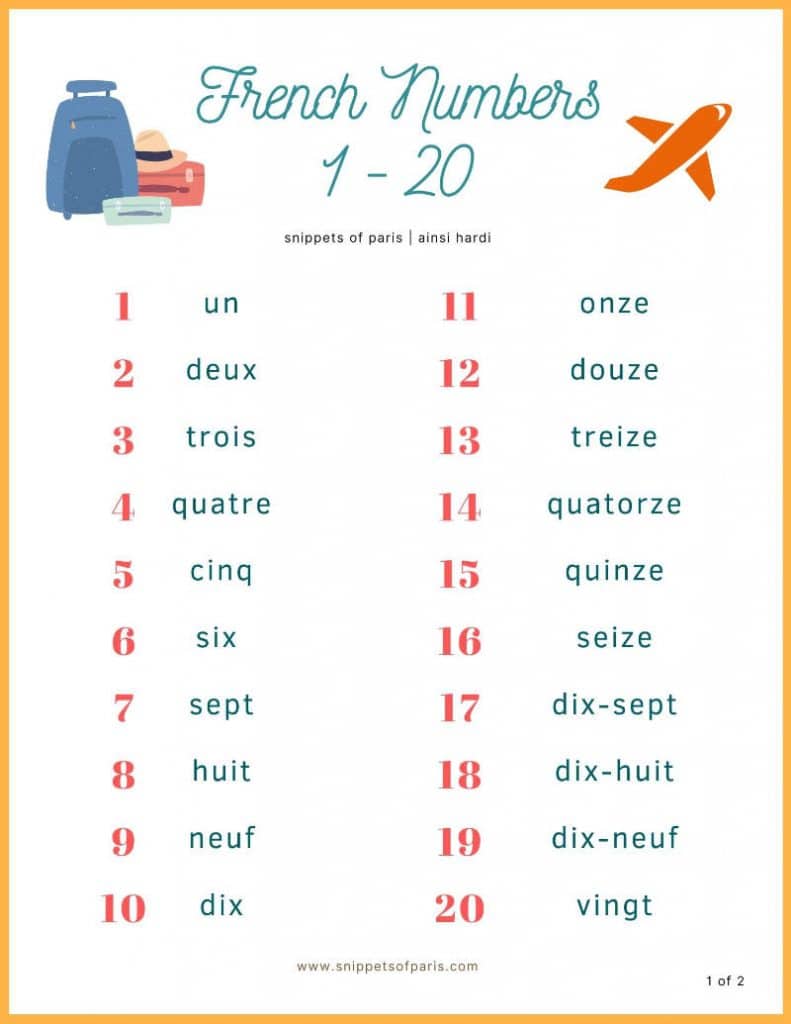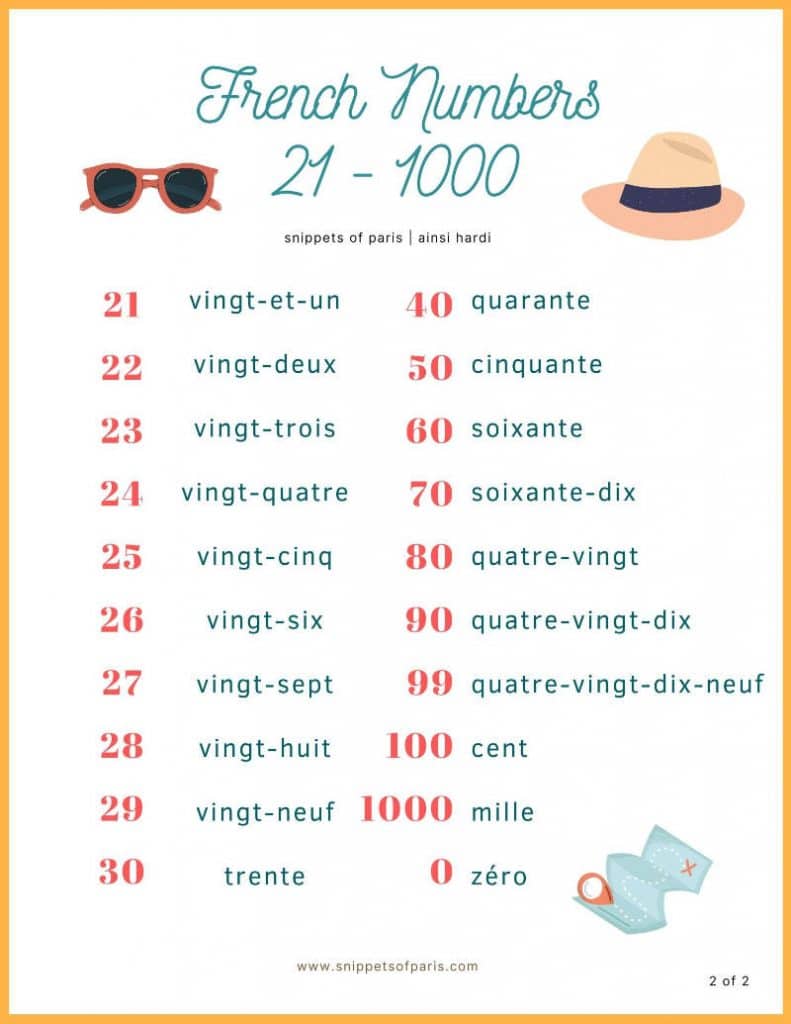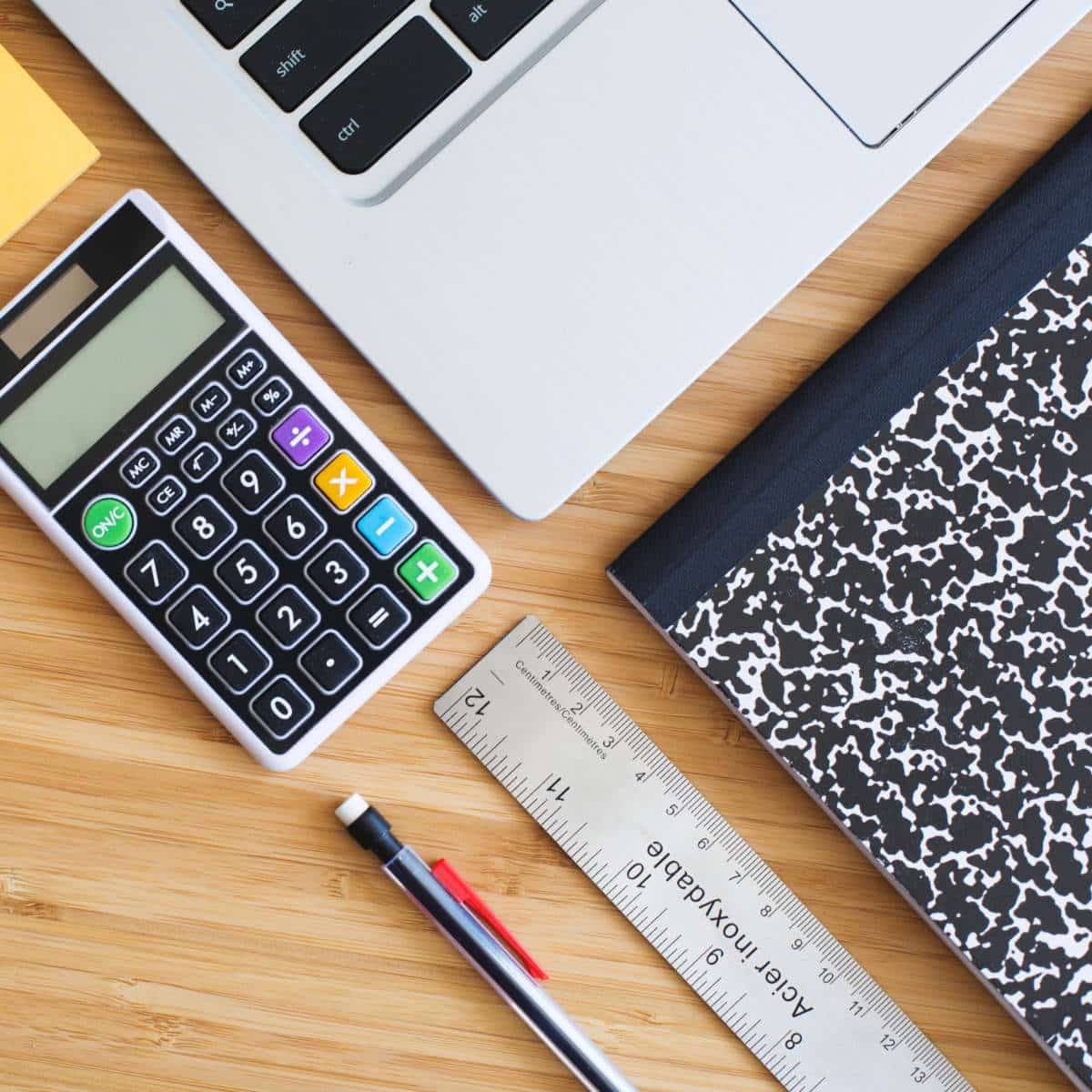If you are trying to learn French, you are going to get to the topic of French numbers quite quickly. I have to warn you, right of the bat, it is not going to be pretty.
Learning numbers in French is unexpectedly complicated, and requires a certain amount of rote-memorization. In order to be able to rattle off large numbers without pausing, you may have to do mathematical calculations in your head.
I will warn you in advance you may be tempted to pull out a calculator. It isn’t the easiest, but with a bit of persistence, it is achievable. So let’s dive into French numbers, shall we? Allons-y!
From 0 to 20
French numbers all start off relatively normally, with 0 to 20 being learnt quite quickly as follows:
- 0 – zéro
- 1 – un
- 2 – deux
- 3 – trois
- 4 – quatre
- 5 – cinq
- 6 – six (pronounced sis)
- 7 – sept
- 8 – huit
- 9 – neuf
- 10 – dix
- 11 – onze
- 12 – douze
- 13 – treize
- 14 – quatorze
- 15 – quinze
- 16 – seize
- 17 – dix-sept
- 18 – dix-huit
- 19 – dix-neuf
- 20 – vingt
Now 17 becomes 10+7, and it is the same for 18 and 19, but that is still not too bad. I know you are thinking “too easy, I got this!”

From 21 to 70
From 21 onwards, there is a slight hick where every figure with 1 is called twenty and one, thirty and one, etc. as follows:
- 20 – vingt
- 21 – vingt-et-un
- 22 – vingt-deux
- 23 – vingt-trois
- 24 – vingt-quatre
- 25 – vingt-cinq
- 26 – vingt-six
- 27 – vingt-sept
- 28 – vingt-huit
- 29 – vingt-neuf
- 30 – trente
- 31 – trente-et-un
- 32 – trente-deux
- 33 – trente-trois
- 34 – trente-quatre
- 35 – trente-cinq
- 36 – trente-six
- 37 – trente-sept
- 38 – trente-huit
- 39 – trente-neuf
- 40 – quarante
- 41 – quarante-et-un
- 42 – quarante-deux
- 43 – quarante-trois
- 44 – quarante-quatre
- 45 – quarante-cinq
- 46 – quarante-six
- 47 – quarante-sept
- 48 – quarante-huit
- 49 – quarante-neuf
- 50 – cinquante
- 51 – cinquante-et-un
- 52 – cinquante-deux
- 53 – cinquante-trois
- 54 – cinquante-quatre
- 55 – cinquante-cinq
- 56 – cinquante-six
- 57 – cinquante-sept
- 58 – cinquante-huit
- 59 – cinquante-neuf
- 60 – soixante
- 61 – soixante-et-un
- 62 – soixante-deux
- 63 – soixante-deux
- 64 – soixante-deux
- 65 – soixante-deux
- 66 – soixante-deux
- 67 – soixante-deux
- 68 – soixante-deux
- 69 – soixante-neuf
As you can see, other than remembering to add an et, the rest of it is easy-peasy.
From 70 to 79
It is at 70, that the wheels start to come off. Instead of coming up with a new word for 70, we start to perform some addition with seventy in French referred to as 60+10.
I kid you not, the whole thing continues as follows:
- 70 – soixante-dix
- 71 – soixante-onze
- 72 – soixante-douze
- 73 – soixante-treize
- 74 – soixante-quatorze
- 75 – soixante-quinze
- 76 – soixante-seize
- 77 – soixante-dix-sept
- 78 – soixante-dix-huit
- 79 – soixante-dix-neuf
So 79 is actually spoken in French as 60+19.
From 81 to 99
And it continues to get more complicated and unwieldy from there, where we graduate from simple addition to multiplication and BODMAS rules. For eighty, the French version becomes four times twenty (4×20) and continues as follows:
- 81 – quatre-vingt-un
- 82 – quatre-vingt-deux
- 83 – quatre-vingt-trois
- 84 – quatre-vingt-quatre
- 85 – quatre-vingt-cinq
- 86 – quatre-vingt-six
- 87 – quatre-vingt-sept
- 88 – quatre-vingt-huit
- 89 – quatre-vingt-neuf
- 90 – quatre-vingt-dix
- 91 – quatre-vingt-onze
- 92 – quatre-vingt-douze
- 93 – quatre-vingt-treize
- 94 – quatre-vingt-quatorze
- 95 – quatre-vingt-quinze
- 96 – quatre-vingt-seize
- 97 – quatre-vingt-dix-sept
- 98 – quatre-vingt-dix-huit
- 99 – quatre-vingt-dix-neuf
So for 90 in the French version becomes 4 x 20 + 10 and 99 is basically 4 x 20 + 10 + 9.
For non-francophones, it is impossible to understand why this hasn’t been revised for the modern era, but there you have it.
Unlike English, there are government institutions and associations that regulate officially spoken French. You cannot just invent words and hope it gets adopted into the official lexicon. The official rules of the French language are decided by an institution called the Académie Française. Created in 1635, it is responsible for defining French language dictionary, grammar and punctuation.
From 100 onwards
Once you get past the chicanery between 70 and 99, it all becomes relatively straightforward. The main French number milestones are as follows:
- 100 – cent
- 1000 – mille
- 1000000 – million
- 1000000000 – billion
Now, this still can get a bit complicated and needs a bit of practice. For example, if you wanted to say €1,895,000, it would be un million, huit cents, quatre-vingt-quinze-mille. That breaks down as follows:
- un million – 1 million
- huit cents – 8 hundred
- quatre-vingt-quinze-mille – (4 x 20 + 15) = 95 thousand
As you can see, you could have quite an advanced level of fluency, and still struggle with figures if you were working in finance in France!

Firsts and Seconds
The good news is that once you have mastered French numbers, you can easily speak of “first, second, third,” etc. It does start off with differences for 1st, but after that it is smooth-sailing. Just add ème at the end, as follows:
- 1er – premier/première
- 2eme – deuxième
- 3eme – troisième
- 90eme – quatre-vingt-dixième
- 99eme – quatre-vingt-dix-neuvième
- 100eme – centième
Fractions
French Fractions are just as easy, with just adding un in the beginning and ème at the end. It does start off with differences for 1/2, 1/3 and 1/4, but after that it is smooth-sailing.
Fractions in French are spoken as follows:
- 1/2 – un demi
- 1/3 – un tiers
- 2/3 – deux-tiers
- 1/4 – un quart
- 1/5 – un cinquième
- 1/10 – un dixème
- 1/20 – un vingtième
- 1/99 – un quatre-vingt-dix-neuvième
This method above mostly only works with 1 over a denominator. If you want to say another figure, such as 7/10 on the other hand, you would say “sept sur dix” meaning 7 on 10.
Another example would be trois sur vingt, meaning 3/20 or deux sur cinq for 2/5.
French Numbers in Belgium and Switzerland
For the French-speaking portions of other countries, you can understand that the complex mathematical calculations of French numbers were a no-go.
Belgium, Switzerland, and other francophone-speaking regions have their own official french language authority institutions to decide what should be in the official numbering system.
Switzerland decided to adapt the numbers above 69 are as follows:
- 70 – septante
- 71 – septante et un
- 72 – septante-deux
- 80 – huitante
- 90 – nonante
- 99 – nonante-neuf
To make it even more confusing however, Belgium followed suite, but is still using quatre-vingt for 80, rather than huitante. Ahh those Belges!
Traditionalist Quebecois government association, however, has decided to stick to the regular French with quatre-vingt, as dictated by the motherland.
☞ READ MORE: Top French travel phrases for every occasion
Phone numbers
Now, this doesn’t sound that bad, until you get to a practical example such as phone numbers. French phone numbers are usually 10 digits long and are written in twos, as follows: 06.22.94.75.77
So if you would like to imagine, the above number will be repeated in French as follows:
- zéro-six (06)
- vingt-deux (22)
- quatre-vingt-quatorze (4 x 20+14 = 94)
- soixante-quinze (60 + 15 = 75)
- soixante-dix-sept (60 + 10 + 7 = 77)
When spoken quickly over the phone, you can see how this jumble of numbers can be difficult for French learners to grasp and ensure that they have written down the correct phone number!
For info, phone numbers that begin with 06 or 07 mean that they are mobile phones, while numbers that start with 01 or 09 mean that you are calling a landline. The area code for France is +33.
Mathematical symbols
I would be amiss if I did not note the most common mathematical symbols, as spoken in French. The usual suspects, aka mathematical symbols are as follows:
| Mathematical Symbol | French As Spoken |
|---|---|
| + Addition (plus) | Un plus deux (1 + 2) |
| – Soustraction (moins) | Deux moins un (2 – 1) |
| x Multiplication | Trois fois cinq (meaning 3 times 5), or Trois multiplié par cinq (meaning 3 multiplied by 5) |
| ÷ Division | Dix divisé par deux (10 ÷ 2) |
| = Egal | Un plus deux est égal à trois (1 + 2 = 3) |
| % Pour cent | Dix pour cent (10%) |
| , Virgule | Trois virgule cinquante (3,50) |
| € Euros | Dix euros (€10) |
| ¢ Centimes | Dix euros et quatre-vingt-dix-neuf centimes (€10,99) |

So are you feeling ready to conquer French numbers? You can download the printables above in pdf format below. And if you enjoyed that article, check out our other resources to learn French. A bientôt!
¹ Featured Image: Sarah Pflug





